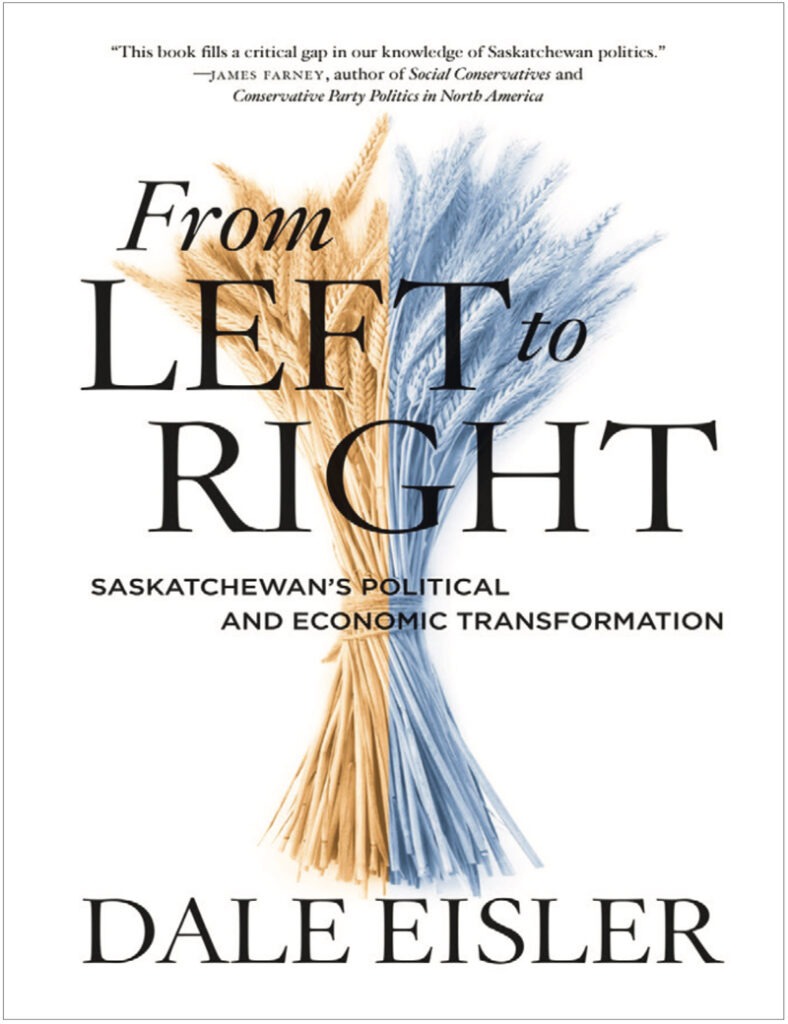A Masterful Story of Modern Saskatchewan

From Left to Right:
Saskatchewan’s Political and Economic Transformation
By Dale Eisler
University of Regina Press/
April 2022
Reviewed by Vianne Timmons
When I was asked to review Dale Eisler’s new book, From Left to Right: Saskatchewan’s Political Transformation, I jumped at the opportunity. As a very busy university president, the deadline would make sure I read the book, and I was looking forward to learning more about the province I fell in love with in my last job. I was not disappointed.
Dale is a storyteller. His words capture personalities and events so that the reader feels like they are at the table during discussions, or in the conversation. He also educates the reader to the connections among politics, the economy and world events. He weaves a tapestry that pulls in threads and paints a complex and intricate mural.
I lived in Saskatchewan for 11 years, fascinated with the stories of the many politicians who had an impact, not just on the province but the nation. Dale connects provincial and national events so that one can understand how our federal and provincial jurisdictions co-exist and yet are fraught with challenges. This is a book about Saskatchewan politics but is also so much more. It is a book about the importance of our Canadian resources, how global events impact locally and how the economy both influences and is influenced by politics.
The beginning of the book introduces us to how events in Saskatchewan, such as the introduction of universal Medicare in 1967, were driven and adopted. Dale notes “the Saskatchewan Medicare model was embraced and implemented as a national program; the magnitude of what Saskatchewan had pioneered became entrenched as a defining moment not just for the province but for the nation.” He also introduces us to the changes in farming, the growth of Crown corporations, the story of potash mining in the province and the impact these have on policy and politics. These individual stories — well researched and well told — draw out the many connections between a resource economy and how it plays out politically.
This book also presents the reader with an understanding of populism in Saskatchewan and then proceeds to draw a relationship to its recent global rise. I found this section very enlightening. Dale is able to take complex ideas and present them so that the reader can make connections to larger political events.
I have always been interested in the rise and fall of political parties and Saskatchewan is a perfect case study of how voters can shift their alliances. The connections between policies — both provincial and federal — such as the Crow Rate, the divide between rural and urban voters and how our politicians respond and react, all provide a compelling narrative.
One strength of the book is how Dale describes the men who have served the province. He is able to capture their personalities and how voters relate to them. I knew Brad Wall personally and Dale describes him as a “dream weaver.” I was witness to many of his speeches over the years I lived in the province and whether his message aligned with my beliefs or not, I always loved to listen, as he is an exceptional orator. Dale captures the qualities of each leader and their characters beautifully.
The book is about how Saskatchewan politics changed over four decades but it is also a story about resilience and determination. After the economically challenging 80s, Saskatchewan was the first province to table a balanced budget. The tenacity of the politicians who ran the province is admirable. It was a difficult path but they stayed firm under the leadership of Roy Romanow. It was accomplished through rural hospital closures, deep spending cuts and tax increases. These actions eventually led to the rise of the Saskatchewan Party and to the decline of the NDP. I found it interesting that it was the NDP that took a path that many would describe as conservative.
Federal/provincial strife and western alienation are also captured in this book. Dale describes the influence of Pierre Trudeau on Saskatchewan politics and how this remained to be transferred to our present prime minister, his son, Justin Trudeau. All through the book, we are led back and forth between federal and provincial politics. It makes this book much more than a story about a province, it is also a story about our country.
The book unfortunately does not address the impact of politics on and by the First Nations Peoples of Saskatchewan. Dale does make one reference in the middle of the book, it is fleeting and definitely not connected to the political scene. I found the same regarding the influence of Saskatchewan women. He mentions Linda Haverstock and Louise Simard however, he does not describe the role they had (or did not have) in Saskatchewan politics. The book describes the politicians who have been influential and I recognize many have been men, but there have been a number of women politicians who have also had an impact. So often, indigenous people and women’s roles are not recognized, it is important that we make them visible.
This book is a great read, one that does describe the Saskatchewan politics and shift from left to right over four decades. The book is comprehensive, the chapters are easy to read and flow beautifully. As mentioned earlier, Dale’s ability to tell stories, describe characters and make connections is masterful. This book would appeal to political junkies; students of political science, public policy, economics, business and history. I highly recommend this book as I enjoyed it immensely.
Policy Contributing Writer Vianne Timmons is President and Vice-Chancellor of Memorial University of Newfoundland, and a former President of University of Regina.
